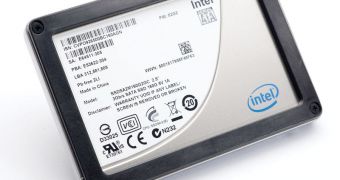Intel is working on developing a new series of enterprise class solid storage disks that will be compliant with the ONFI 3.0 standard and that will drop the current TSOP NAND packaging, common for today's SSDs, in favor of BGA NAND Flash.
TSOP stands for Thin Small-Outline Package and this technology has been used for a wide variety of computer integrated controllers as well as for most NAND Flash chips manufactured today.
Its main advantage is that it is cheap to produce, but the faster speeds brought by the ONFI 3.0 standard forced Intel, as well as other NAND Flash makers, to find an alternative to this technology for its next generation chips.
One of the answers seems to be the much more expensive to produce BGA (Ball Grid Array) technology that Intel plans to employ in its upcoming enterprise SSDs.
According to a leaked slide that was posted online by VR-Zone, the transition has already started and will target only the enterprise sector.
The consumer market won't see any such drives in 2011 and it is possible that Intel will go with some other form of packaging for this space as pricing is of the utmost importance.
In addition to the new packaging, Intel also plans to increase the capacity of its NAND Flash which could reach between 16 and 64 GB in size by the end of the year.
These new chips will be most probably built using the IMFT 20nm manufacturing technology.
Compared to the 2.2 version of the standard, ONFI 3.0 is able to reach transfer speeds as high as 400MB/sec per channel as it swaps the current DDR-200 interface with an NV-DDR2 interface.
In addition, the new standard brings support for lower I/O signaling voltages and on-die terminations to improve the signal integrity.

 14 DAY TRIAL //
14 DAY TRIAL // 

